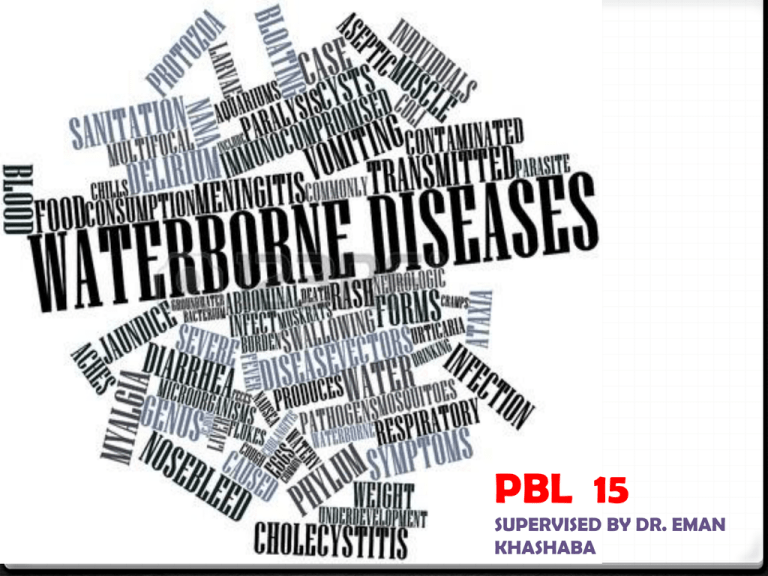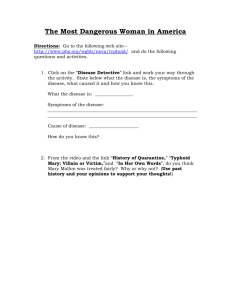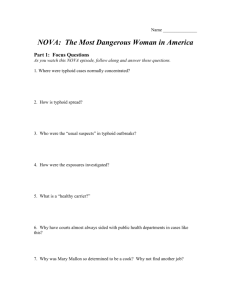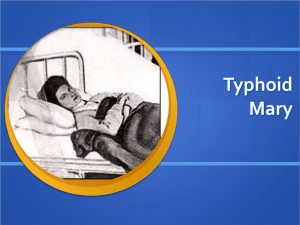File
advertisement

PBL 15 SUPERVISED BY DR. EMAN KHASHABA PAY ATTENTION PLEASE !!!! Objectives Epidemic 0 Sudden appearance of disease in a certain area & in specific time. 0 Or the occurrence of an illness in excess of normal expectation based on past experience in a community or specific area. 0 Mainly caused by consumption of contaminated food or water Characteristics of Epidemic 0 Explosive in character affecting a large number of people in 0 0 0 0 0 a short period of time (1ry wave). All ages , both sexes and all socioeconomic status are affected. Distribution of cases follow distribution of water supply thus it could be traced to source of infection. 1ry wave is preceded by a smaller wave of diarrhea (due to simultaneous pollution with organisms which cause diarrhea with shorter incubation period). 1ry wave is followed by a smaller and less abrupt 2ry wave of enteric infection. Once source is discovered & controlled [ new cases of infection decrease rapidly. Causative agents of Epidemic Bacteria Salmonella spp ,Campylobacter jejuni ,Shigella spp, Enterotoxigenic E. coli (ETEC) Virus Hepatitis A&E .Norovirus -Rotavirus -Rubivirus Parasites Entamoeba histolytica -Giardia lamblia Cryptosporidium spp. Toxin Corynebacterium Diphtherriae -Bacillus cereus Clostridium botulinum Risk Factors of Water & Food Borne 0 Age: Young children &Elderly persons. 0 Food traditions: Intentionally undercooked or raw meats and fish (e.g., steak tartare, sushi, and oysters). 0 Hygiene: lack of clean water, infected food handlers, or hand washing is not possible. 0 Disasters: earthquakes, volcanic eruptions, landslides, tsunamis, floods, and drought due to damage in infrastructure including public water supply and sewage drainage system. Clinical Manifestation of Water & Food Borne Diseases FEVER, RASHES DYSENTRY IRRITATED EYES VOMITTING ABD. CRAMPS SORE THROAT DIARRHEA SYSTEMIC ILLNESS PNEUMONIA Epidemic Water Borne in Malaysia & Egypt Year Place Cause No Of Cases Typhoid Mary 1907 USA Contaminated Food prepared by Typhoid Mary 3500 Epidemic In Malaysia (Typhoid) 1997 -Kelantan -Sabah -Terengganu Contamination of river water & drinking water 180 Epidemic In August 2009 Egypt (Typhoid) -Qolioubiya -Abu Qurqas -Fayoum Breakdown 342 sewage drainage system Tajikistan (Typhoid) Dushanbe Contimination Death : 95 of the municipal 8901 cases water system Feb 1997 Incidence Rate of Typhoid in Malaysia 2000-2011 (per 100,000 population) 4.5 4 3.5 3 2.5 2 1.5 1 0.5 0 2001 2002 2003 2004 2005 2006 2007 2008 2009 2010 2011 Steps of outbreak investigation 1. Verification of diagnosis. 2. Confirmation of the existence of an epidemic. 3. Cases finding and their characteristics. 4. Study of environmental factors 5. Investigations of population at risk. 6. Data analysis. 7. Formulation of hypothesis. 8. Recommendation for prevention & control Prevention of Water & Food- borne Epidemic 1- General Prevention: 2. Specific prevention A .Environmental sanitation: 1. Adequate supply of safe drinking water. 2. Sanitary disposal of wastes (refuse & sewage). 3. Insect eradication that can cause epidemic (flies & cockroaches). 4. Food sanitation: - Strict measures for food preparation, processing or handling.+- Control of food handlers . A. Immunization • Vaccines.:Typhoid -Hepatitis A - Polio vaccine- Cholera B. Health Education: • Of the public about the natural of water & foodborne diseases and mode of transmission. B. Chemoprophylaxis • Tetracyclin for Cholera. • Deoxycycline prophylaxis for Shigella. • Ciprofloxacin for Salmonella. Control Measures Ecological Measures Food-borne Take food samples for examination. Water-borne Water examination and sampling from suspected source around distribution of cases Superchlorination Environmental measures 1. 2. 3. 4. 5. Avoid use of untreated sewage water for irrigation of crops unless proved safe. Boil preserve food just before eating Get rid of spoiled canned food of odors or changed taste Avoid eating / catching fishes in contaminated water. Report any confirmed cases of food-borne illnesses to province/territory. 1. Repairing the water treatment and distribution systems. 2. Evaluated municipal drinking water quality and water wastage. 3. Municipal water supplies should routinely monitored by frequent bacteriological and chemical testing. Public health measures Meat sanitation and proper cooking Pasteurization or boiling of milk Good personal hygiene of food handler Boiling all drinking water. Conserving municipal water Promoting basic hygiene measures to prevent the TYPHOID MARY 0 The most notorious carrier of typhoid fever—but by no means the most destructive—was Mary Mallon, also known as Typhoid Mary. 0 In 1907, she became the first American carrier to be identified and traced. She was a cook in New York. 0 She is closely associated with fifty-three cases and three deaths. Public health authorities told Mary to give up working as a cook or have her gall bladder removed. 0 Mary quit her job but returned later under a false name. She was detained and quarantined after another typhoid outbreak. She died of pneumonia after 26 years in quarantine. SUMMARY 0 Determining the sources of foodborne illness is the important part of identifying opportunities to improve food safety. 0 Having a better sense of the relationship between contaminated food and illness supports food safety along the entire food production change 0 One way with approach attribution, estimation is to use the data collected during foodborne outbreaks investigation. ARE YOU READY FOR THE QUIZ? 0 1. What is the first step for outbreak investigation ? 0 2. One of the following is wrong regarding water borne disease control measures : A. Boiling all drinking water B. Avoid catching fish in contaminated water C. Superchlorination D. Evaluated municipal drinking water quality & water wastage THANK YOU 0 Hidayah 0 Syamimi 0 Adriana 0 Batrisha 0 Ainur Nelissa 0 Haziqah 0 Heba 0 Adham 0 Arif Rozain 0 Afiq 0 Abbas




